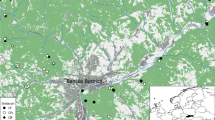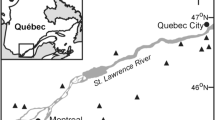Abstract
We examined effects of abandonment on species diversity and species composition by comparing 21 calcareous fen meadows in the pre-alpine zone of central and northeastern Switzerland. Meadows were divided into three classes of successional stages (mown: annually mown in late summer, young fallow: 4–15 years, and old fallow: >15 years of abandonment). In each fen, we measured litter mass in four 20 cm×20 cm plots, as well as (aboveground) biomass and species density (number of species per unit area) of bryophytes and vascular plants. Bryophyte biomass was reduced in abandoned fens, whereas litter mass and aboveground biomass of vascular plants increased. Species density of both taxonomic groups was lower in abandoned than in mown fens. Young and old successional stages were not different except for bryophytes, for which old successional stages had higher species density than young stages. We used litter mass and aboveground biomass of vascular plants as covariables in analyses of variance to reveal their effects on species density of both taxonomic groups. For bryophytes, litter mass was more important than vascular plant biomass in explaining variance of species density. This indicates severe effects of burying by litter on bryophyte species density. For species density of vascular plants, both vascular plant biomass and litter mass were of similar importance in explaining the decreased species density. Canonical correspondence analyses showed that abandonment also had an effect on species composition of both bryophytes and vascular plants. However, young and old successional stages were not different indicating fast initial changes after abandonment, but slow secondary succession afterwards. Furthermore, indicator species analysis showed that there was no establishment of new species after abandonment that might dramatically alter fen communities. Re-introduction of mowing as a nature conservation strategy may thus be very promising – even for old fallows.
Similar content being viewed by others
References
Bates J.W. (1988). The effects of shoot spacing on the growth and branch development of the moss Rhytidiadelphus triquetrus. New Phytol. 109:499–504
Bergamini A. and Pauli D. (2001). Effects of increased nutrient supply on bryophytes in montane calcareous fens. J. Bryol. 23:331–339
Bergamini A., Pauli D., Peintinger M. and Schmid B. (2001a). Relationships between productivity, number of shoots and number of species in bryophytes and vascular plants. J. Ecol. 89:920–929
Bergamini A., Peintinger M., Schmid B. and Urmi E. (2001b). Effects of management and altitude on bryophyte species diversity and composition in montane calcareous fens. Flora 196:180–193
Bergamini A. and Peintinger M. (2002). Effects of light and nitrogen on morphological plasticity of the moss Calliergonella cuspidata. Oikos 96:355–363
Billeter R. (2001). Secondary succession in fens - from communities to genes. Dissertation, University of Zürich, Zürich
Billeter R. and Diemer M. (2000). Effects of abandonment on Tofieldia calyculata (Liliaceae), a common, subdominant wetland species. Bull. Geobot. Inst. ETH 66:37–46
Billeter R., Hooftman D. and Diemer M. (2003). Differential and reversible responses of common fen meadow species to abandonment. Appl. Veget. Sci. 6:3–12
Bosshard A., Andres F., Stromeyer S. and Wohlgemuth T. (1988). Wirkung einer kurzfristigen Brache auf das Ökosystem eines anthropogenen Kleinseggenriedes. Berichte Geobot. Inst. ETH, Stiftung Rübel, Zürich 54:181–220
Brülisauer A. and Klötzli F. (1998). Habitat factors related to the invasion of reeds (Phragmites australis) into wet meadows of the Swiss Midlands. Zeits. Ökol. Nat. 7:125–136
Buch H. 1947. Über die Wasser- und Mineralnährstoffversorgung der Moose I, II. Soc. Sci. Fenn. Comment. Biol. 9(16):1–44, 9(20):1–49
Buchwald R. (1996). Basikline Pfeifengraswiesen (Molinietum caeruleae) und ihre Kontaktvegetation im weiteren Alb-Wutach-Gebiet (Hochrhein, SW-Deutschland). I. Verbreitung, Synsystematik und Verbrachung der Pfeifengraswiesen. Tuexenia 16:179–225
BUWAL (1990). Inventar der Flachmoore von nationaler Bedeutung. Entwurf zur Vernehmlassung. Bundesamt für Umwelt, Wald und Landschaft (BUWAL) Bern
Diemer M., Oetiker K. and Billeter R. (2001). Abandonment alters community composition and canopy structure of Swiss calcareous fens. Appl. Veget. Sci. 4:237–246
Dufrêne M. and Legendre P. (1997). Species assemblages and indicator species: the need for a flexible asymmetrical approach. Ecol. Monogr. 67:345–366
Ellenberg H. (1996). Vegetation Mitteleuropas mit den Alpen in ökologischer, dynamischer und historischer Sicht. Ulmer, Stuttgart
Facelli J.M. and Pickett S.T.A. (1991). Plant litter: its dynamics and effects in plant community structure. Bot. Rev. 57:1–32
Frego K.A. and Carleton T.J. (1995). Microsite tolerance of four bryophytes in a mature black spruce stand: reciprocal transplants. The Bryologist 98:452–458
Geissler P., Urmi E. and Schnyder N. 1998. Liste der Moose der Schweiz und ihrer Grenzgebiete. In: Schneider H. and Paulsen J. (eds.). CD Schweizer Botanik ’98, Basel
Güsewell S., Buttler A. and Klötzli F. (1998). Short and long-term effects of mowing on the vegetation of two calcareous fens. J. Veget. Sci. 9:861–872
Hájková P. and Hájek M. (2003). Species richness and above-ground biomass of poor and calcareous spring fens in the flysch West Carpathians, and their relationships to water and soil chemistry. Preslia 75:271–287
Ingerpuu N., Vellak K., Kukk T. and Pärtel M. (2001). Bryophyte and vascular plant species richness in boreo-nemoral moist forest and mires. Biodivers. Conserv. 10:2153–2166
Jensen K. (1998). Species composition of soil seed bank and seed rain of abandoned wet meadows and their relation to aboveground vegetation. Flora 193:345–359
Jensen K. and Meyer C. (2001). Effects of light competition and litter on the performance of Viola palustris and on species composition and diversity of an abandoned fen meadow. Plant Ecol. 155:169–181
Jensen K. and Schrautzer J. (1999). Consequences of abandonment for a regional fen flora and mechanisms of succesional stages. Appl. Veget. Sci. 2:79–88
Jonsson B.G. (1993). The bryophyte diaspore bank and its role after small-scale disturbance in a boreal forest. J. Veget. Sci. 4:819–826
Kimmerer R.W. and Young C.C. (1996). Effect of gap size and regeneration niche on species coexistence in bryophyte communities. Bull. Torrey Bot. Club 123:16–24
Klimeš L., Dančak M., Hájek M., Jongepierová I. and Kučera T. (2001). Scale-dependent biases in species counts in grassland. J. Veget. Sci. 12:699–704
Lauber K. and Wagner G. (1996). Flora Helvetica. Paul Haupt, Bern
Maas D. (1988). Keimung und Etablierung von Streuwiesenpflanzen nach experimenteller Ansaat. Nat. Landschaft 63:411–415
McCullagh P. and Nelder J.A. (1983). Generalized Linear Models. Chapman and Hall, London
McCune B. and Mefford J.M. (1997). PC-ORD. Multivariable Analysis of Ecological Data, Version 3.0. MjM Software Design, Gleneden Beach (Oregon)
Nash Suding K. and Goldberg D.E. (1999). Variation in the effects of vegetation and litter on recruitment across productivity gradients. J. Ecol. 87:436–449
Økland R.H. (2000). Population biology of the clonal moss Hylocomium splendens in Norwegian boreal spruce forests. 5. Vertical dynamics of individual shoot segments. Oikos 88:449–469
Pauli D., Peintinger M. and Schmid B. (2002). Nutrient enrichment in calcareous fens: effects on plant species and community structure. Basic Appl. Ecol. 3:255–266
Payne R.W., Lane P.V., Digby P.G.N., Harding S.A., Leech P.K., Morgan G.W., Todd A.D., Thompson R., Tunnicliffe Wilson G., Welham S.J. and White R.P. (1993). GENSTAT 5 Release 3. Reference Manual. Oxford University Press, Oxford
Peintinger M., Bergamini A. and Schmid B. (2003). Species-area relationships and nestedness of four taxonomic groups in fragmented wetlands. Basic Appl. Ecol. 4:385–394
Proctor M.C.F. (1981). Physiological ecology of bryophytes. Adv. Bryol. 1:79–166
Rincon E. (1988). The effects of herbaceous litter on bryophyte growth. J. Bryol. 15:209–217
Rincon E. and Grime J.P. (1989). Plasticity and light interception by six bryophytes of contrasted ecology. J. Ecol. 77:439–446
Rosenthal R. and Rosnow R.L. (1985). Contrast Analysis: Focused Comparisons in the Analysis of Variance. Cambridge University Press, Cambridge
Rydin H. (1997). Competition among bryophytes. Adv. Bryol. 6:135–168
Ryser P., Langenauer R. and Gigon A. (1995). Species richness and vegetation structure in a limestone grassland after 15 years management with six biomass removal regimes. Folia Geobot. Phytotaxon. 30:157–167
Schiefer J. 1981. Bracheversuche in Baden-Württemberg. – Beihefte zu den Veröffentlichungen für Naturschutz und Landschaftspflege in Baden-Württemberg 22: 1–325
Stöcklin J. and Gisi U. (1989). Auswirkungen der Brachlegung von Mähwiesen auf die Produktion pflanzlicher Biomasse und die Menge und Struktur der Streudecke. Acta Oecol. Oecol. Appl. 10:259–270
Sundberg S. and Rydin H. (2002). Habitat requirements for establishment of Sphagnum from spores. J. Ecol. 90:268–278
ter Braak C.F.J. (1986). Canonical correspondence analysis: a new eigenvector technique for multivariable direct gradient analysis. Ecology 67:1167–1179
ter Braak C.F.J. and Smilauer P. (1998). CANOCO Reference Manual and User’s Guide to CANOCO for Windows. Software for Canonical Community Ordination (version 4). Centre for Biometry, Wageningen
Uttinger H. 1967. Klima und Wetter II. In: Imhof E. (ed.), Atlas der Schweiz, Tafel 12. Eidgenössische Landestopographie, Bern-Wabern (Switzerland)
Vanderpoorten A., Delescaille L.-M. and Jacquemart A.-L. (2003). The bryophyte layer in a calcareous grassland after a decade of contrasting mowing regimes. Biol. Conserv. 117:11–18
von Tooren B.F., van Dam D. and During H.J. (1988). Effects of simulated shade on growth, morphology and competitive interactions in two pleurocarpous mosses. J. Bryol. 20:301–310
von Tooren B.F., Odé B., During H.J. and Bobbink R. (1990). Regeneration of species richness in the bryophyte layer of Dutch chalk grasslands. Lindbergia 16:153–160
Voser-Huber M.-L. 1992. Goldruten – Probleme in Naturschutzgebieten. Schriftenreihe Umwelt 167 (Bundesamt für Umwelt, Wald und Landschaft): 1–22
Wheeler B.D. and Giller K.E. (1982). Species richness of herbaceous fen vegetation in Broadland, Norfolk, in relation to the quantity of above-ground plant material. J. Ecol. 70:179–200
Xiong S. and Nilsson C. (1999). The effects of plant litter on vegetation: a meta-analysis. J. Ecol. 87:984–994
Xiong S., Johansson M.E., Hughes F.M.R., Hayes A., Richards K.S. and Nilsson C. (2003). Interactive effects of soil moisture, vegetation canopy, plant litter and seed addition on plant diversity in a wetland community. J. Ecol. 91:976–986
Zoller H. and Bischof N. (1980). Stufen der Kulturintensität und ihr Einfluss auf Artenzahl und Artengefüge der Vegetation. Phytocoenologia 7:35–51
Acknowledgements
We thank Regula Billeter and Matthias Diemer for allowing us to use their field design and for improving a previous version of the manuscript, Oliver Schelske for help in the field and Karin Oetiker for providing her soil pH data. The study was financed partly by a grant of the Swiss National Science Foundation (Project 31-50669.97) to M. Diemer.
Author information
Authors and Affiliations
Corresponding author
Rights and permissions
About this article
Cite this article
Peintinger, M., Bergamini, A. Community structure and diversity of bryophytes and vascular plants in abandoned fen meadows. Plant Ecol 185, 1–17 (2006). https://doi.org/10.1007/s11258-005-9079-y
Received:
Accepted:
Published:
Issue Date:
DOI: https://doi.org/10.1007/s11258-005-9079-y




